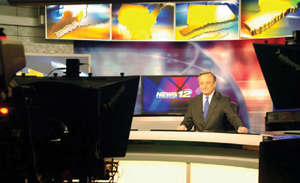Prompting From the User’s Viewpoint

Liz Motley, anchor of the World Evening News on RFD TV
SEATTLE: From the days when teleprompter operators taped together pages of scripts and rolled them on a conveyor belt under a cheapie camera to present day iPads, teleprompters have been an ever-present part of newscast studios. On the engineering and operations side, prompter purchasers have an array of buying points to keep in mind: interfacing with newsroom computer system, weight, ruggedness, power requirements, cost, etc.
There’s another side of the equation, however: the needs and preferences of on-air news anchors who make a living reading the scripts off these teleprompters.
“Size matters… the bigger the better in the studio,” said John Pozadzides, host and CEO of Livid Lobster, Inc., parent company of online tech news site Geek Beat.
Pozadzides said he normally sits about 12 feet from the prompter, but for green-screen work, he can stand as far as 20 feet from the prompter. “If you have a prompter screen that’s too small, you can’t compensate because the words will get just so big as you back away from it. [With a large prompter screen], if you move closer you can always decrease the size of the font.”
Livid Lizard uses a ProPrompter system in its studio.
CUSTOMIZING SCREENS
“Every anchor is different, unique,” said Liz Motley, anchor of the World Evening News on RFD TV, a 24-hourcable network targeting rural communities. “Some people have better vision, and some anchors may have a harder time reading a teleprompter. You have to have a system that can be customized.”
Tom Appleby, news anchor for cable news network News 12 Connecticut In addition to the prompter screen being large, Motley said “I like the fact that we can customize font styles. Things that are easier to read for one person may not be for another. Font style, font color, just being able to adapt what’s on the screen.”
She also credits smooth scrolling with helping anchor talent deliver the news smoothly. In her shop the production assistant who controls prompter scrolling saves settings for each anchor, which includes scrolling rate and font style and color. “I stick with black and white… it works best for me.”
RFD TV uses an Autocue/QTV prompter system in its studio.
‘GOOD FOR EVERYBODY’
For Tom Appleby, news director and news anchor for cable news network News 12Connecticut, the key is to find a prompter system that works for the whole staff.
“In a shop like ours, with a dozen hours of newscasts a day, you average it out and find a font size that’s good for everybody,” he said.
While he prefers a big font, Appleby said it’s also important that the prompter screen be large enough that more than just a few words or lines of copy appear on the screen.“The bigger the font, the less of a sentence you see at any one time. And that’s an issue…those sentences can get long, and you haven’t got a clue where the pause is going to come, or whether it’s a short sentence. If you’re only seeing five or six words, you’re a little bit at sea until you move that prompter up to the rest of the sentence.”
News 12 Connecticut uses an Autoscript prompter system in its studios.
VIEWABILITY
“The ability to add color can enhance a reader’s experience and the ability to invert the text [black text over white background or white text over black background] is very helpful,” said Milan Krainchich, vice president of production/operations, News 12 Networks.“However, it is important to pick a standard and stick with it.”
Having the prompter scroll along on its own during play out of edited packages is very helpful to free the operator or anchor from having to have a hand on the controller during packages. “The ability to have multiple hand controls and foot pedals on the same system is a must,” Krainchich said. “Studios may have multiple sets. A controller is also needed off the sets in the studio, and one is usually placed in the control room. Any one of a number of people can then seamlessly take over the controls.”
News 12 Long Island uses a Listec teleprompter system.
It seems to be a split decision as to whether anchors would prefer to control their own scrolling.
“In this shop we control our own,” said News 12 Connecticut’s Appleby. “I would say it’s been about 15 years since we’ve had someone run a prompter for us. We do it ourselves, and I don’t think there’s a person in this shop who would cede it back to someone in the control room doing it. The pace, knowing when you want to take a breath, when you want to swallow, no one can anticipate that as well as you can.”

“I am baffled and troubled by the recent trend to ask anchors to operate their own teleprompters during live broadcasts,” he said. “It’s the equivalent of trying to pat your head and rub your belly at the same time. I’ve used both systems and I know from personal experience how running your own prompter distracts from any attempt to communicate and connect with the audience in any meaningful way.”
So in addition to engineering and operations considerations when buying or upgrading a prompter system, it might be a good idea to sit with the anchors at the news desk, and walk a mile in their shoes.
The professional video industry's #1 source for news, trends and product and tech information. Sign up below.
